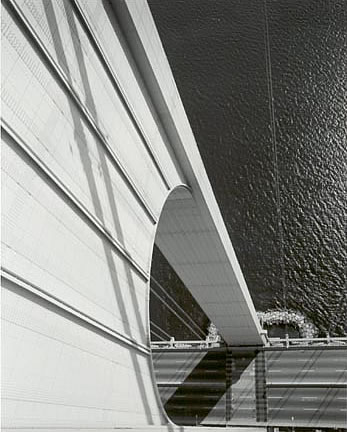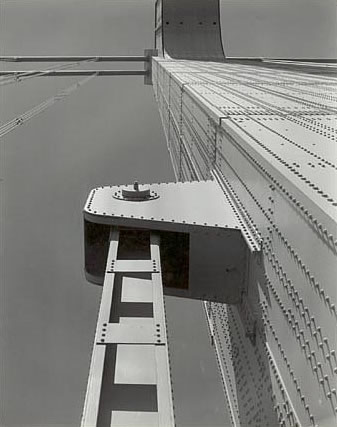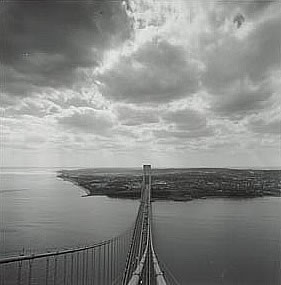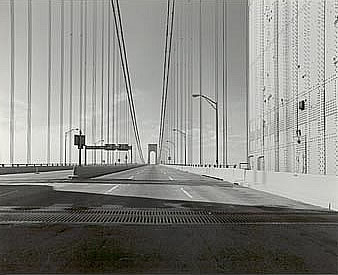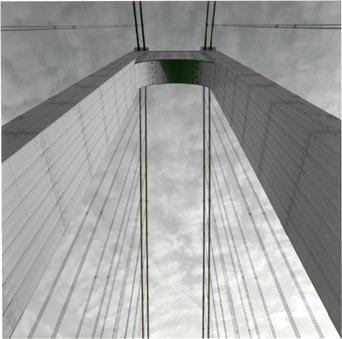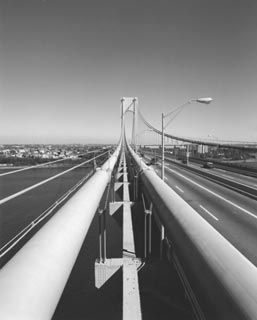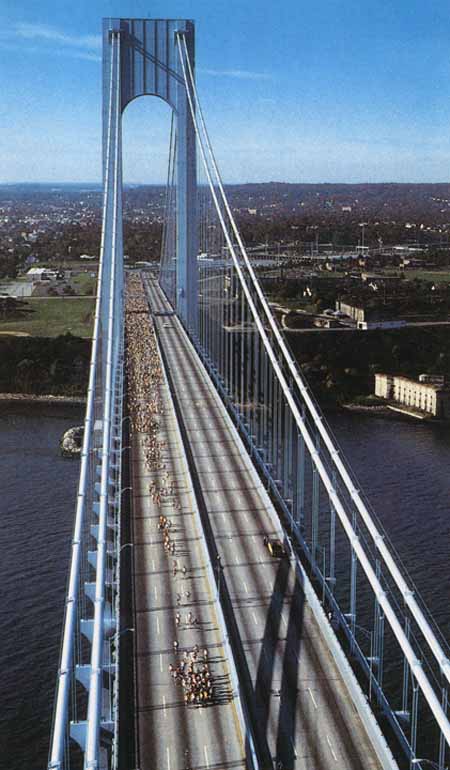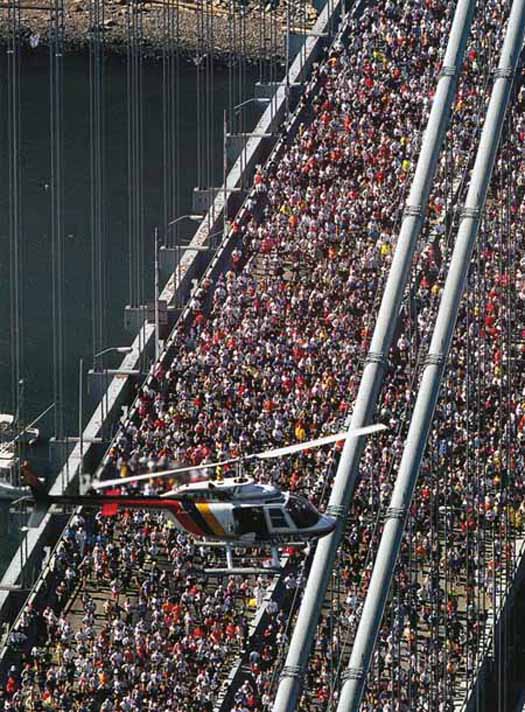|
The Verrazano-Narrows Bridge is a double-decked
suspension bridge that connects the boroughs of Staten Island and
Brooklyn in New York City at the Narrows, the reach connecting the
relatively protected upper bay with the larger lower bay.
The bridge is named for Italian explorer Giovanni da Verrazzano, the
first known European navigator to enter New York Harbor and the Hudson
River, while crossing The Narrows. It has a center span of 4,260 feet
(1,298 m) and was the largest suspension bridge in the world from the
time of its completion in 1964 until 1981. It now has the seventh
longest center span in the world but still is the largest suspension
bridge in the United States. Its massive towers can be seen throughout a
good part of the New York metropolitan area, including from spots in all
five boroughs of New York City.
The bridge furnishes a critical link in the local and regional highway
system. It is widely known today as the starting point of the New York
City Marathon. The bridge marks the gateway to New York Harbor; all
cruise ships and most container ships arriving at the Port of New York
and New Jersey must pass underneath the bridge. Most ships, when built,
must be built to accommodate the clearance under the bridge. Among local
residents it is often referred to as simply the "Verrazano."
History
The bridge is owned by New York City and operated by the Triborough
Bridge and Tunnel Authority, an affiliate agency of the Metropolitan
Transportation Authority. Interstate 278 passes over the Bridge
connecting the Staten Island Expressway with the Brooklyn-Queens
Expressway and the Belt Parkway. The Verrazano, along with the other
three major Staten Island bridges, created a new way for commuters and
travelers to reach Brooklyn, Long Island, and Manhattan by car from New
Jersey.
The bridge was the last great public works project in New York City
overseen by Robert Moses, the New York State Parks Commissioner and head
of the Triborough Bridge and Tunnel Authority, who had long desired the
bridge as means of completing the expressway system which was itself
largely the result of his efforts. The bridge was designed by Chief
Engineer Othmar Ammann, who had also designed most of the other major
crossings of New York City, including the George Washington Bridge, the
Bayonne Bridge, the Bronx Whitestone Bridge, the Triborough Bridge and
the Throgs Neck Bridge. It was his last project. The plans to build the
bridge caused considerable controversy in the neighborhood of Bay Ridge,
since many families had settled in homes in the area where the bridge
now stands and were forced to relocate.
Construction on the bridge started on August 13, 1959 and the upper deck
was opened on November 21, 1964 at a cost of over $320 million. New York
City Mayor Robert F. Wagner cut the ribbon at the opening ceremony,
which was attended by over 5,000 people. The lower deck opened on June
28, 1969. The bridge took over the title of the longest suspension
bridge in the world, previously held by the Golden Gate Bridge, from
1964 until 1981, when it was eclipsed by the Humber Bridge in England.
Fort Lafayette was an island coastal fortification in New York Harbor,
built next to Fort Hamilton at the southern tip of what is now Bay
Ridge. It was destroyed as part of the bridge's construction in 1960;
the Brooklyn-side bridge pillars now occupy the fort's former foundation
site.
According to the United States Department of Transportation:
Each of the two towers contains 1,000,000 bolts and 3,000,000 rivets.
The diameter of each of the four suspension cables is 36". Each cable is
composed of 26,108 wires amounting to a total of 143,000 miles in length
Due to the height of the towers (690') and their distance apart (4260'),
the curvature of the earth's surface had to be taken into account when
designing the bridge -- the towers are 1⅝ inches farther apart at their
tops than at their bases.[3]
Due to thermal expansion/contraction of steel, the bridge roadway is 12'
lower in summer than its winter elevation.
The bridge, because of its size and isolated location, close to the open
ocean, is more vulnerable to the elements than any other bridge in the
city. It has been closed, either partially or entirely, occasionally
during strong wind and snow storms.
The Queen Mary 2 had to revise its smokestack height in order for it to
pass under the bridge, and still has barely 3m (9.75ft) of clearance.[4]
September 11, 2001
On the morning of September 11, 2001, United Airlines Flight 175 was
hijacked and flown directly over the Verrazano-Narrows Bridge en route
to the World Trade Center. Metropolitan Transportation Authority
officials had earlier expressed concern about the plane's proximity to
the bridge and later closed the bridge's upper deck after the plane
struck the South Tower. When details of the attack on the Pentagon
emerged, the MTA shut down the Verrazano-Narrows bridge, along with most
other traffic throughout the city. After the collapse of the North
Tower, the MTA opened both an eastbound and westbound lane of the bridge
to allow traffic to flow briefly before closing it again at 1 PM that
day. It remained closed until the following morning at 9 AM.[citation
needed]
Naming controversy
The naming of the bridge for Verrazzano was highly controversial at the
time. It was first proposed in 1951 by the Italian Historical Society of
America, when the bridge was in the planning stage. After the initial
proposal was turned down by Moses, the Society undertook a public
relations campaign to both re-establish the reputation of the
largely-forgotten Verrazano and to promote the idea of naming the bridge
for him. The promotional campaign was largely the effort of Society
director John N. LaCorte, who in 1954 successfully lobbied Governor of
New York W. Averell Harriman to proclaim April 17 (the anniversary of
Verrazano's arrival in the harbor) as "Verrazano Day". Subsequent
efforts by LaCorte resulted in similar proclamations by governors of
states along the East Coast. After these successes, LaCorte approached
the Triborough Bridge and Tunnel Authority again, but was turned down a
second time. The manager of the authority, backed by Moses, stated that
the name was too long and that he had never heard of Verrazano.
The Society later succeeded in lobbying to get a bill introduced in the
New York State Assembly that would name the bridge for the explorer.
After the introduction of the bill, the Staten Island Chamber of
Commerce joined the Society in promoting the name. The bill was signed
into law in 1960 by Governor Nelson Rockefeller. Although the
controversy seemed settled, the naming issue rose again in the last year
of construction after the assassination of John F. Kennedy. A petition
to name the bridge for Kennedy received thousands of signatures and
threatened the naming for the explorer. In response, LaCorte contacted
United States Attorney General Robert Kennedy, the president's brother,
who told LaCorte that he would make sure the bridge would not be named
for his brother. (What had been known as Idlewild Airport, New York's
major international airport, was named for him instead). Coincidentally,
the bridge opened just one day before the first anniversary of John
Kennedy's death.
Despite the success of LaCorte, the official name was widely ignored by
local news outlets at the time of the dedication. Some radio announcers
and newspapers omitted any reference to Verrazano, referring to the
bridge as the "Narrows Bridge", or the "Brooklyn-Staten Island Bridge".
The Society continued its lobbying efforts to promote the name in the
following years until the name became firmly established.
Bridge usage
The one-way toll (paid westbound into Staten Island only) in cash is $9
per car or $4 per motorcycle. E-ZPass users get a discount of $1.00 per
car.
There is a reduced toll of $4.80 (as of March 19, 2007) for Staten
Island residents; there is also a significant carpool discount. From
1964 to 1986, the toll was collected in both directions, until Staten
Island residents concerned about pollution from idling vehicles called
for one way tolls. However, as of 2007, the eastbound toll booths are
still in place, requiring drivers to slow down. While the high cost of
the toll between Staten Island and Brooklyn has always been an issue for
residents, some favor the toll because they see it as a way to curb
population growth on Staten Island.
Sign on the bridge indicating the border between boroughs.The original
plans of the bridge included a pedestrian and bicycle walkway. However,
those plans were never realized. Recently, there has been demand by
residents living on both ends of the bridge to allow pedestrian access.
In October of 2003, Mayor Michael Bloomberg promised to see what he
could do to realize the long-awaited pedestrian and bicycle access.
References
^ Verrazano-Narrows Bridge (I-278). Retrieved on 2007-05-28.
^ 2005 NYSDOT Traffic Data Report: AADT Values for Select Toll
Facilities. Retrieved on 2007-05-05.
^ Verrazano-Narrows Bridge, accessed March 6, 2007
^ Cruise Ship Profile, accessed July 13, 2006
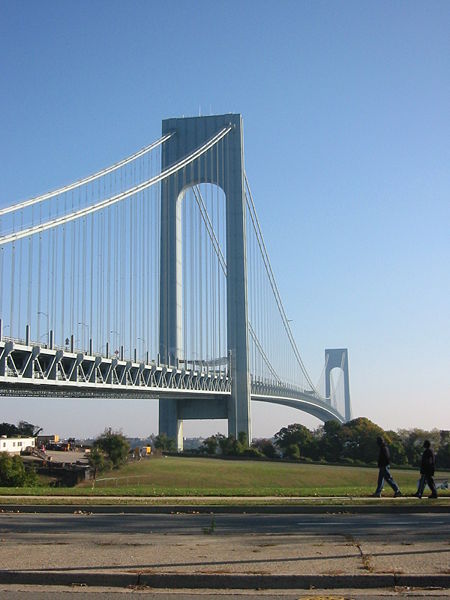
|




